PHOTOGRAPHS OF TOPAZ MOUNTAIN RHYOLITE
The Miocene Topaz Mountain Rhyolite is composed of coalescing flows and
domes of topaz-bearing alkali rhyolite and stratified tuff. Rhyolite eruptions
consisted of an early, explosive phase that deposited stratified tuff followed
by quiet eruption of viscous lava. In early publications, stratified tuff
is described as "vitric tuff" and "water-laid tuff,"
but only some of the tuff is still glassy and epiclastic tuff of undoubted
water-laid origin is rare. Petrologic and chemical studies of the tuff show
that it has been extensively altered to the zeolite mineral, clinoptilote
(Lindsey, 1975a). Volcanologists interpret the stratified tuff as having
been deposited by airfall, ashflow, and base surge processes (Burt and Sheridan,
1981; Christiansen and others, 1986).
The Topaz Mountain Rhyolite is famous for occurrences of topaz, garnet,
beryl, bixbyite, and other minerals in vapor-phase cavities. Vapor-phase
minerals are described by Staatz and Carr (1964). The petrogenesis of the
rhyolite is described and compared with other topaz rhyolites in the western
United States by Christiansen and others (1984, 1986).
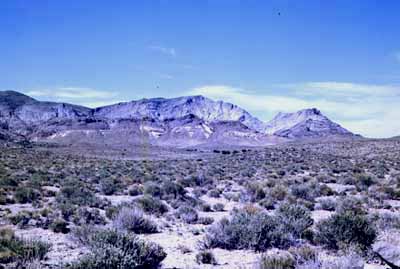 SLIDE 26 shows Topaz Mountain, the type locality of the Miocene (6-7
Ma) Topaz Mountain Rhyolite, looking north from the beryllium road. Topaz
Valley is below the notch in the right side of the mountain. From top to
bottom, the rhyolite consists of gray rhyolite flows, black vitrophyre,
and light-colored stratified tuff.
SLIDE 26 shows Topaz Mountain, the type locality of the Miocene (6-7
Ma) Topaz Mountain Rhyolite, looking north from the beryllium road. Topaz
Valley is below the notch in the right side of the mountain. From top to
bottom, the rhyolite consists of gray rhyolite flows, black vitrophyre,
and light-colored stratified tuff.
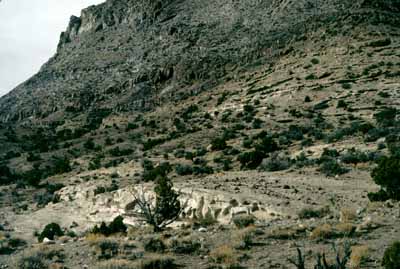 SLIDE 27 is a section of Topaz Mountain Rhyolite on the east side of
Topaz Mountain. The section consists of (top to bottom) gray rhyolite flows,
dark-colored vitrophyre with columnar jointing, brown fused tuff, and cream-colored
stratified tuff (foreground). Stratified tuff rests on the Joy Tuff. The
view is to the west, from above the Autunite No. 8 uranium prospect.
SLIDE 27 is a section of Topaz Mountain Rhyolite on the east side of
Topaz Mountain. The section consists of (top to bottom) gray rhyolite flows,
dark-colored vitrophyre with columnar jointing, brown fused tuff, and cream-colored
stratified tuff (foreground). Stratified tuff rests on the Joy Tuff. The
view is to the west, from above the Autunite No. 8 uranium prospect.
 SLIDE 28 shows stratified tuff of the Topaz Mountain Rhyolite filling
a paleovalley immediately north of the Autunite No. 8 prospect. Once thought
to be water-laid, some of these beds may have been deposited by ground surges
of hot ash.
SLIDE 28 shows stratified tuff of the Topaz Mountain Rhyolite filling
a paleovalley immediately north of the Autunite No. 8 prospect. Once thought
to be water-laid, some of these beds may have been deposited by ground surges
of hot ash.
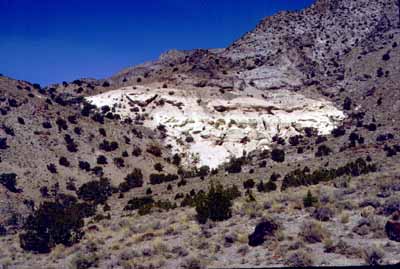 SLIDE 29 shows tuff of Topaz Mountain Rhyolite filling a paleovalley
west of Topaz Mountain (east side of The Dell). Rhyolite flows overlying
tuff near here contain garnet in vapor-phase cavities.
SLIDE 29 shows tuff of Topaz Mountain Rhyolite filling a paleovalley
west of Topaz Mountain (east side of The Dell). Rhyolite flows overlying
tuff near here contain garnet in vapor-phase cavities.
 SLIDE 30 is the view northeast from the Drum Mountains, showing a sequence
of rhyolite flows, vitrophyre, and tuff of Topaz Mountain Rhyolite on Antelope
Ridge. Dugway Valley is in the foreground. Outcrops in left foreground are
black glass tuff member of the Joy Tuff.
SLIDE 30 is the view northeast from the Drum Mountains, showing a sequence
of rhyolite flows, vitrophyre, and tuff of Topaz Mountain Rhyolite on Antelope
Ridge. Dugway Valley is in the foreground. Outcrops in left foreground are
black glass tuff member of the Joy Tuff.
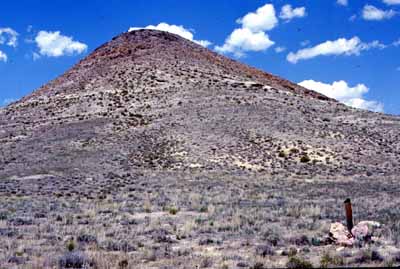 SLIDE 31 is crossbedded tuff of Topaz Mountain Rhyolite at the south
end of Antelope Ridge.
SLIDE 31 is crossbedded tuff of Topaz Mountain Rhyolite at the south
end of Antelope Ridge.
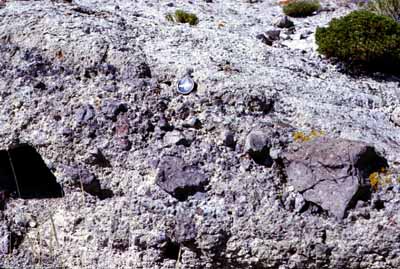 SLIDE 32 is stony tuff, abundant at Antelope Ridge. Most stones are
flow rock of Topaz Mountain Rhyolite, but older volcanic rocks are common.
Lens cap in center shows scale.
SLIDE 32 is stony tuff, abundant at Antelope Ridge. Most stones are
flow rock of Topaz Mountain Rhyolite, but older volcanic rocks are common.
Lens cap in center shows scale.
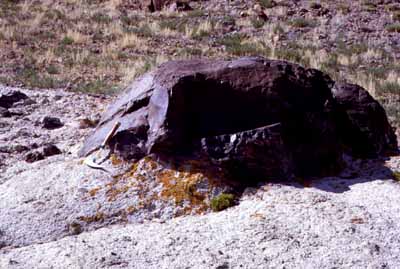 SLIDE 33 shows a large lithic fragment in tuff of Topaz Mountain Rhyolite
at Antelope Ridge. The lithic fragment is welded ash-flow tuff of Oligocene
Joy Tuff. Lithic fragments like this one were evidently ejected from nearby
vents that erupted Topaz Mountain Rhyolite through the Joy Tuff.
SLIDE 33 shows a large lithic fragment in tuff of Topaz Mountain Rhyolite
at Antelope Ridge. The lithic fragment is welded ash-flow tuff of Oligocene
Joy Tuff. Lithic fragments like this one were evidently ejected from nearby
vents that erupted Topaz Mountain Rhyolite through the Joy Tuff.
 SLIDE 34 shows pumice-rich tuff near Wildhorse Springs, north of The
Dell. Pumice forms beds as much as several meters thick, massive to graded
with a sharp base, as shown here. These pumice beds were probably formed
by small ash flows.
SLIDE 34 shows pumice-rich tuff near Wildhorse Springs, north of The
Dell. Pumice forms beds as much as several meters thick, massive to graded
with a sharp base, as shown here. These pumice beds were probably formed
by small ash flows.
 SLIDE 26 shows Topaz Mountain, the type locality of the Miocene (6-7
Ma) Topaz Mountain Rhyolite, looking north from the beryllium road. Topaz
Valley is below the notch in the right side of the mountain. From top to
bottom, the rhyolite consists of gray rhyolite flows, black vitrophyre,
and light-colored stratified tuff.
SLIDE 26 shows Topaz Mountain, the type locality of the Miocene (6-7
Ma) Topaz Mountain Rhyolite, looking north from the beryllium road. Topaz
Valley is below the notch in the right side of the mountain. From top to
bottom, the rhyolite consists of gray rhyolite flows, black vitrophyre,
and light-colored stratified tuff. SLIDE 27 is a section of Topaz Mountain Rhyolite on the east side of
Topaz Mountain. The section consists of (top to bottom) gray rhyolite flows,
dark-colored vitrophyre with columnar jointing, brown fused tuff, and cream-colored
stratified tuff (foreground). Stratified tuff rests on the Joy Tuff. The
view is to the west, from above the Autunite No. 8 uranium prospect.
SLIDE 27 is a section of Topaz Mountain Rhyolite on the east side of
Topaz Mountain. The section consists of (top to bottom) gray rhyolite flows,
dark-colored vitrophyre with columnar jointing, brown fused tuff, and cream-colored
stratified tuff (foreground). Stratified tuff rests on the Joy Tuff. The
view is to the west, from above the Autunite No. 8 uranium prospect. SLIDE 28 shows stratified tuff of the Topaz Mountain Rhyolite filling
a paleovalley immediately north of the Autunite No. 8 prospect. Once thought
to be water-laid, some of these beds may have been deposited by ground surges
of hot ash.
SLIDE 28 shows stratified tuff of the Topaz Mountain Rhyolite filling
a paleovalley immediately north of the Autunite No. 8 prospect. Once thought
to be water-laid, some of these beds may have been deposited by ground surges
of hot ash. SLIDE 29 shows tuff of Topaz Mountain Rhyolite filling a paleovalley
west of Topaz Mountain (east side of The Dell). Rhyolite flows overlying
tuff near here contain garnet in vapor-phase cavities.
SLIDE 29 shows tuff of Topaz Mountain Rhyolite filling a paleovalley
west of Topaz Mountain (east side of The Dell). Rhyolite flows overlying
tuff near here contain garnet in vapor-phase cavities. SLIDE 30 is the view northeast from the Drum Mountains, showing a sequence
of rhyolite flows, vitrophyre, and tuff of Topaz Mountain Rhyolite on Antelope
Ridge. Dugway Valley is in the foreground. Outcrops in left foreground are
black glass tuff member of the Joy Tuff.
SLIDE 30 is the view northeast from the Drum Mountains, showing a sequence
of rhyolite flows, vitrophyre, and tuff of Topaz Mountain Rhyolite on Antelope
Ridge. Dugway Valley is in the foreground. Outcrops in left foreground are
black glass tuff member of the Joy Tuff. SLIDE 31 is crossbedded tuff of Topaz Mountain Rhyolite at the south
end of Antelope Ridge.
SLIDE 31 is crossbedded tuff of Topaz Mountain Rhyolite at the south
end of Antelope Ridge. SLIDE 32 is stony tuff, abundant at Antelope Ridge. Most stones are
flow rock of Topaz Mountain Rhyolite, but older volcanic rocks are common.
Lens cap in center shows scale.
SLIDE 32 is stony tuff, abundant at Antelope Ridge. Most stones are
flow rock of Topaz Mountain Rhyolite, but older volcanic rocks are common.
Lens cap in center shows scale. SLIDE 33 shows a large lithic fragment in tuff of Topaz Mountain Rhyolite
at Antelope Ridge. The lithic fragment is welded ash-flow tuff of Oligocene
Joy Tuff. Lithic fragments like this one were evidently ejected from nearby
vents that erupted Topaz Mountain Rhyolite through the Joy Tuff.
SLIDE 33 shows a large lithic fragment in tuff of Topaz Mountain Rhyolite
at Antelope Ridge. The lithic fragment is welded ash-flow tuff of Oligocene
Joy Tuff. Lithic fragments like this one were evidently ejected from nearby
vents that erupted Topaz Mountain Rhyolite through the Joy Tuff. SLIDE 34 shows pumice-rich tuff near Wildhorse Springs, north of The
Dell. Pumice forms beds as much as several meters thick, massive to graded
with a sharp base, as shown here. These pumice beds were probably formed
by small ash flows.
SLIDE 34 shows pumice-rich tuff near Wildhorse Springs, north of The
Dell. Pumice forms beds as much as several meters thick, massive to graded
with a sharp base, as shown here. These pumice beds were probably formed
by small ash flows.